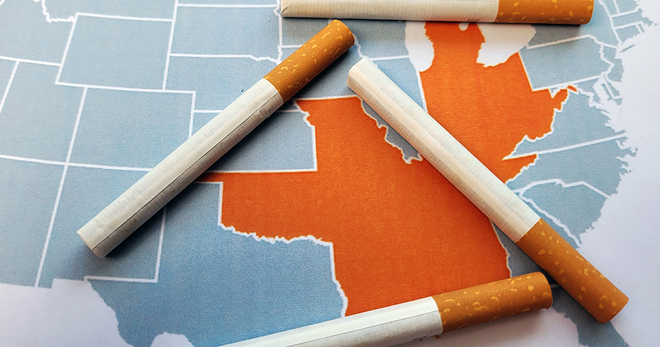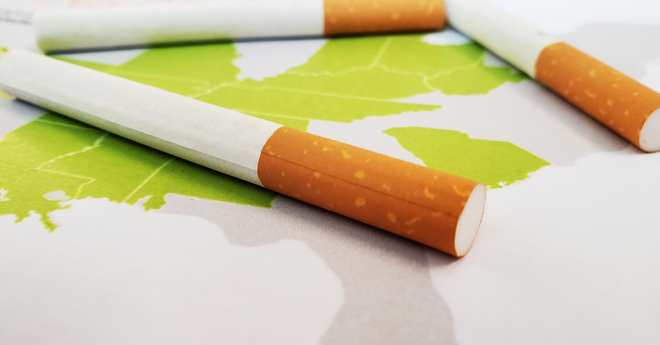Tobacco use in New York 2023
Cigarette use: New York*
Smoking rate in New York
- In 2022, 11.3% of adults in New York smoked. Nationally, the adult smoking prevalence was 14.0%.1
- In 2021, 5.0% of high school students in New York smoked cigarettes on at least one day in the past 30 days. Nationally, the rate was 3.8%.2
Other tobacco product use: New York*
Vaping rate in New York
- In 2022, 7.2% of adults in New York used e-cigarettes. Nationally, adult e-cigarette use prevalence was 7.7%.1
- In 2022, 1.7% of adults in New York used smokeless tobacco everyday or some days. Nationally, adult smokeless tobacco use prevalence was 3.4% 1
- In 2021, 15.7% of high school students in New York used electronic vapor products on at least one day in the past 30 days. Nationally, e-cigarette use prevalence among high school students was 18%.2
- In 2021, 3.9% of high school students in New York used chewing tobacco, snuff or dip on at least one day in the past 30 days. Nationally, smokeless tobacco use prevalence among high school students was 2.5%.2
- In 2021, 4.4% of high school students in New York smoked cigars, cigarillos or little cigars on at least one day in the past 30 days. Nationally, cigar use prevalence among high school students was 3.1%.2
Economics of tobacco use and tobacco control
Tobacco taxes in New York
- New York received $1.9 billion (estimated) in revenue from tobacco settlement payments and taxes in fiscal year 2022.4
- Of this, the state allocated $39.2 million in state funds to tobacco prevention in fiscal year 2023, 19.3% of the Centers for Disease Control and Prevention’s annual spending target.4
- Smoking-caused health care costs: $12.07 billion per year.4
- Smoking-caused losses in productivity: $18.2 billion per year.5
New York tobacco laws
New York tobacco laws
Tobacco taxes
- New York is ranked 1st in the U.S. for its cigarette tax of $5.35 per pack (enacted September 2023), compared to the national average of $1.93. (Missouri has the lowest at 17 cents.)6-8
- Little cigars weighing less than four pounds per thousand are taxed at 21.75 cents per cigar. Snuff is taxed at $2 per ounce and a proportionate rate on fractional parts of an ounce, provided that cans or packages of snuff with a net weight less than one ounce are taxed at the equivalent rate of cans or packages weighing one ounce. Vapor products are taxed at 20% of the retail price. All other tobacco products are taxed at 75% of the wholesale price.6,7,9
Clean indoor air ordinances
- Smoking is prohibited in all government workplaces, private workplaces, schools, childcare facilities, restaurants, bars (allowed in cigar bars and allows for an economic hardship waiver), casinos/gaming establishments (tribal establishments exempt), retail stores and recreational/cultural facilities.6,7
- E-cigarettes are included in the state’s clean indoor air law.9
Flavor restrictions
- The sale of all flavored e-cigarettes is prohibited, except e-cigarettes that have been approved by the U.S. Food and Drug Administration as part of a premarket review.10
Licensing laws
- Retailers and wholesalers are required to obtain a license to sell tobacco products.6
- A license is required to sell e-cigarettes.9
- The sale of tobacco products, including vapor products, is prohibited in pharmacies.11
Point of sale laws
- Retailers are prohibited from redeeming coupons or other discounting measures for tobacco products.12
Youth access laws
- In December 2019, the United States adopted a law raising the federal minimum age of sale of all tobacco products to 21, effective immediately.
- Establishments are required to post signs stating that sales to minors are prohibited and will be penalized.6,7
- In stores where admission is not restricted to individuals 21 and older, tobacco products for sale must be store behind the counter or in a locked container.6,7
- Minors are prohibited from buying e-cigarettes, vapor products, or liquid nicotine.
- Retailers are prohibited from engaging in discount sales (e.g. coupons, multipack discounts) of vapor products (with some exceptions).9
- Advertisements for electronic cigarettes and vapor products intended to be used for the consumption of nicotine are prohibited from display in store fronts, exterior windows and doors of stores within 1,500 feet of a school (in New York City, this provision applies to stores within 500 feet of a school).9
Local tobacco laws
- New York City:
- Prohibits the sale of all flavored e-cigarettes10
- Prohibits the sale of flavored tobacco products with a characterizing flavor other than menthol, mint or wintergreen, except in certain “tobacco bars”10
- Prohibits the use of all tobacco products at all ticketed sporting events, including at Citi Field and Yankee Stadium13
- Requires that cigarettes and little cigars not be sold at retail for less than $13 per 20-pack, including sales tax14
- Requires cigars that cost less than $3 individually be sold in packs of four or more13
- Requires little cigars be sold in packs of 2015
- Manheim prohibits the sale of all flavored tobacco products.10
- Yonkers prohibits the sale of flavored e-cigarettes.10
- Hempstead and Nassau County prohibit the sale of e-cigarettes within 1,000 feet of a school, playground or park. Lowville prohibits smoke shops and tobacco stores from being located within 1500 feet from a school, or other similar places where children regularly gather.10
- Washington County prohibits smoking tobacco or cannabis products on county property.10
Quitting statistics and benefits
Quitting smoking and vaping in New York
- The CDC estimates 46.8% of daily adult smokers in New York quit smoking for one or more days in 2019.3
- In 2014, the Affordable Care Act required that Medicaid programs cover all tobacco cessation medications.7**
- New York’s state quit line invests $2.37 per smoker, which is the national median.7
- New York does not have a private insurance mandate provision for quitting tobacco. But, the state’s insurance commissioner issued guidance instructing most insurance plans to be in compliance with Affordable Care Act guidance on tobacco cessation as a preventative service.7
Notes and references
Notes and references
* The datasets for both adults and youth prevalence were used to make direct comparisons at the state and national levels. National prevalence reported here may differ from what is reported in our national-level fact sheets. The numbers here also reflect the most recent data available. Dates of available data may differ across state fact sheets.
**The seven recommended cessation medications are NRT gum, NRT patch, NRT nasal spray, NRT inhaler, NRT lozenge, Varenicline (Chantix) and Bupropion (Zyban).
Fiore MC, et al. Treating Tobacco Use and Dependence: 2008 Update. Clinical Practice Guideline. Rockville, MD: US Department of Health and Human Services. Public Health Service: May 2008.
1. CDC, Behavioral Risk Factor Surveillance System, 2022.
2. CDC, Youth Risk Behavioral Surveillance System, 2021.
3. CDC, Behavioral Risk Factor Surveillance System, State Tobacco Activities Tracking and Evaluation System, 2021.
4. Campaign for Tobacco-Free Kids, Broken Promises to Our Children: a State-by-State Look at the 1998 State Tobacco Settlement 24 Years Later FY2023, 2023.
5. Campaign for Tobacco-Free Kids, Toll of Tobacco in the United States.
6. American Lung Association, State Legislated Actions on Tobacco Issues (SLATI).
7. American Lung Association, State of Tobacco Control, 2023.
8. Campaign for Tobacco-Free Kids. State Cigarette Excise Tax Rates & Rankings. https://www.tobaccofreekids.org/assets/factsheets/0097.pdf. Accessed October 4th, 2023.
9. Public Health Law Center. U.S. E-Cigarette Regulation: 50-State Review. http://www.publichealthlawcenter.org/resources/us-e-cigarette-regulations-50-state-review. Accessed October 4th, 2023.
10. Truth Initiative, Local restrictions on flavored tobacco and e-cigarette products. https://truthinitiative.org/research-resources/emerging-tobacco-products/local-restrictions-flavored-tobacco-and-e-cigarette. Accessed October 4th, 2023.
11. Americans Nonsmokers' Rights Foundation. Municipalities with Tobacco-Free Pharmacy Laws. http://no-smoke.org/pdf/pharmacies.pdf. Accessed October 4th, 2023.
12. New York State Governor Andrew Cuomo. Governor Cuomo Announces Highlights of FY 2021 Budget. https://www.governor.ny.gov/news/governor-cuomo-announces-highlights-fy-2021-budget. Published 2020. Accessed October 4th, 2023.
13. New York City Department of Health and Mental Hygiene. Smoking and Tobacco Control Laws. https://www1.nyc.gov/site/doh/business/food-operators/smoking-legislation.page. Accessed October 4th, 2023.
14. New York City Council. Int 1544-2017: A Local Law to amend the administrative code of the city of New York, in relation to the regulation of retail dealers of tobacco products and of electronic cigarettes, the establishment of price floors and minimum package sizes for tobacco products and shisha, and the establishment of a tax on tobacco products other than cigarettes. http://legistar.council.nyc.gov/LegislationDetail.aspx?ID=3013584&GUID=2CF281E1-5407-4AB5-8340-E16098EF7F85&FullText=1 Published 2017. Accessed October 4th, 2023.
15. New York City Department of Health and Mental Hygiene. New Laws Governing Cigar Sales in New York City Tobacco Retail Stores: What You Need to Know. https://www1.nyc.gov/assets/doh/downloads/pdf/smoke/cigar-sales-faq.pdf. Accessed October 4th, 2023.
More in smoking by region
Want support quitting? Join EX Program
By clicking JOIN, you agree to the Terms, Text Message Terms and Privacy Policy.
Msg&Data rates may apply; msgs are automated.




